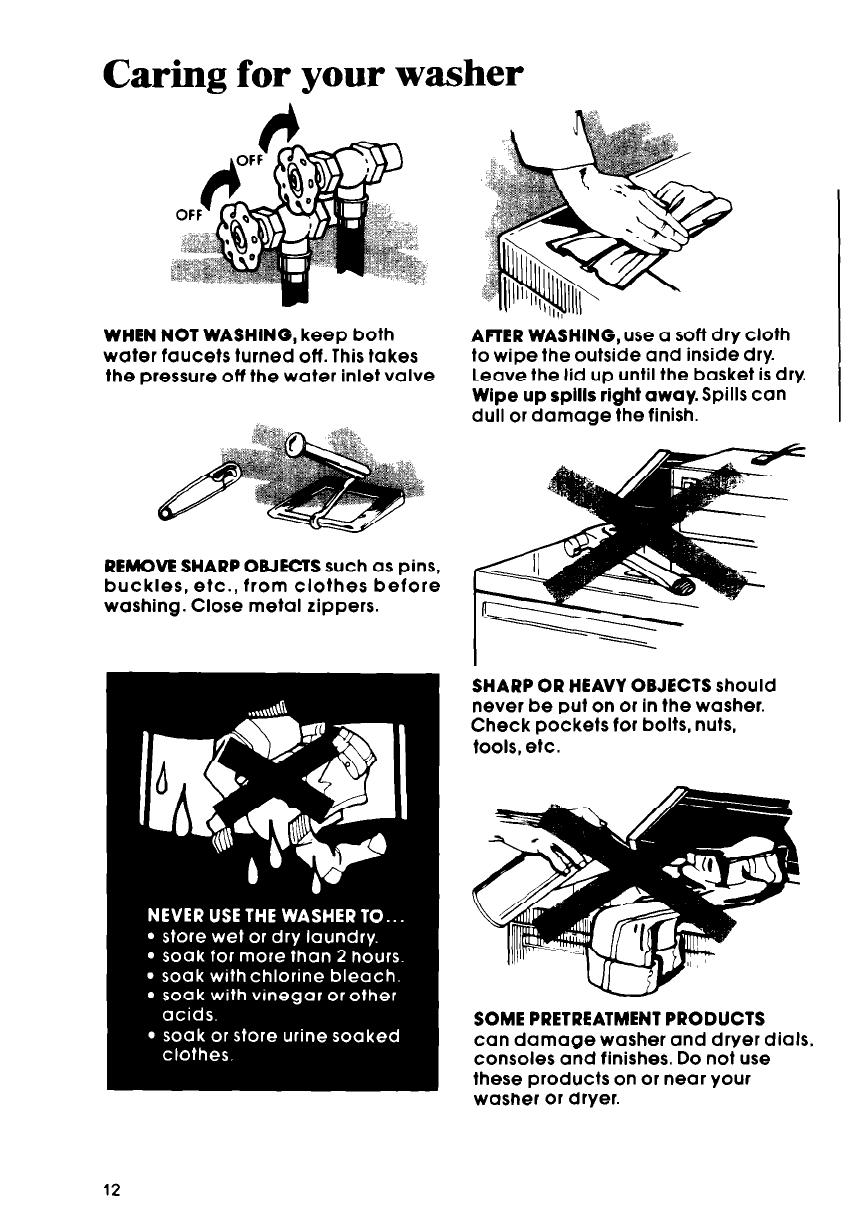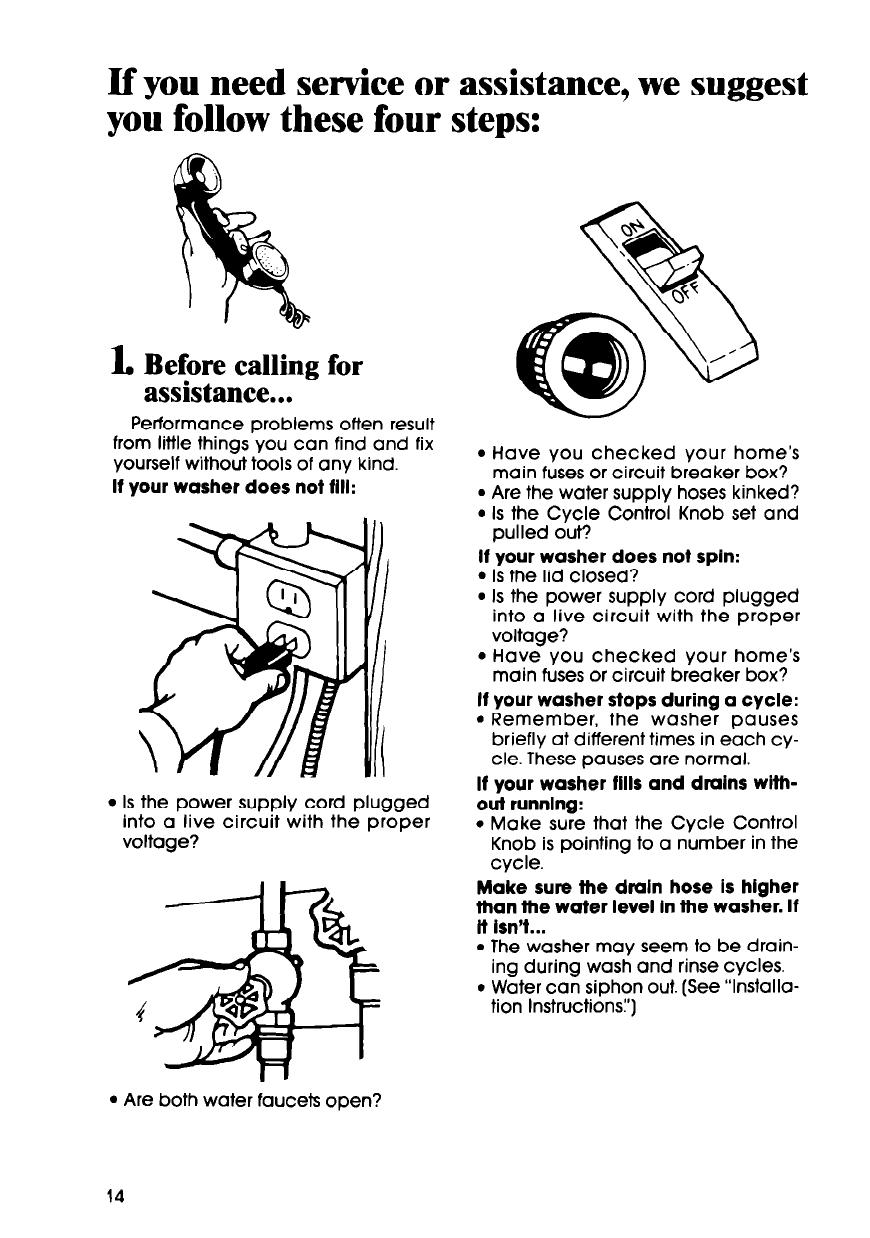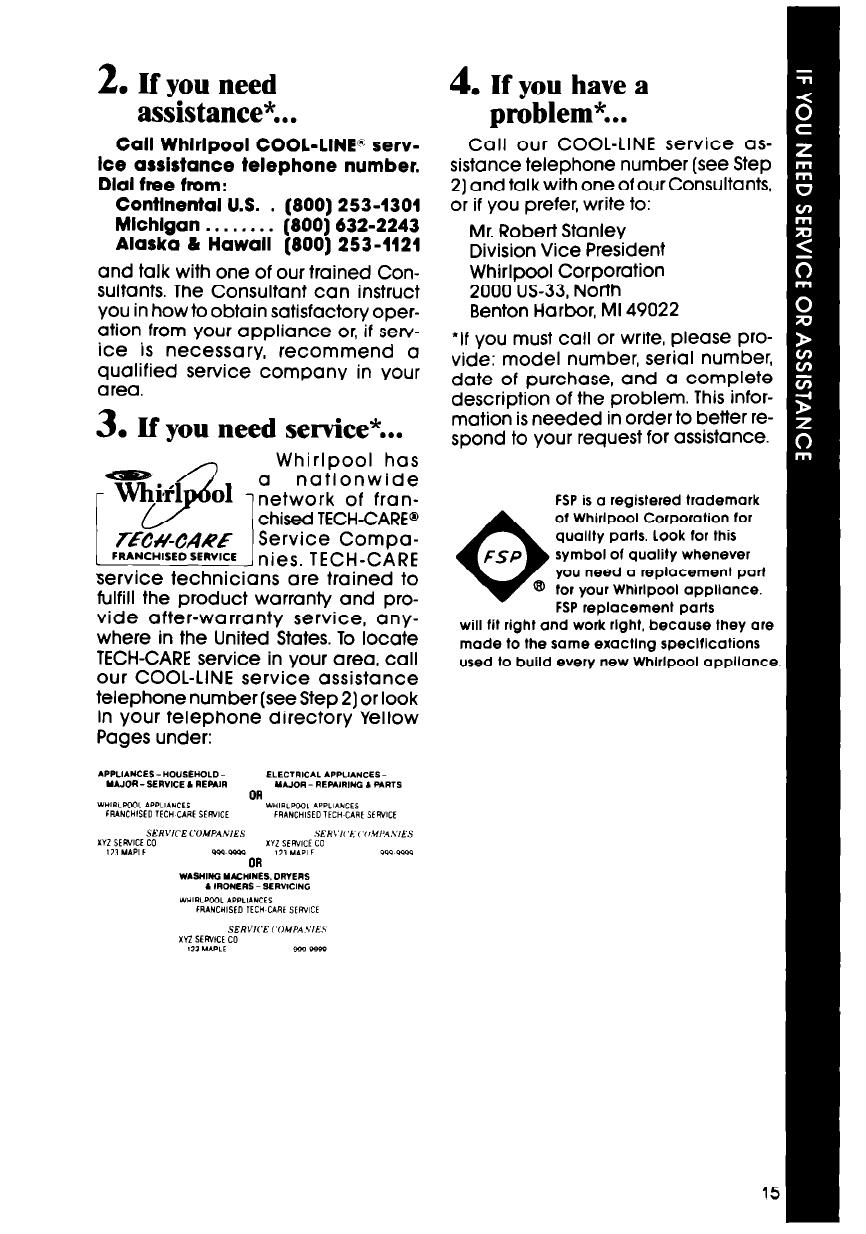
.
) &d!& SERIES 1
AUTOMATIC
WASHER
Design 2000”
~oF&CaP=iW
LA62OOXP
Microwave Ovens. Trash Compactors. Room Aar Condltloners. Oehumldtflers Aulomatlc Washers. Clothes Oryers. Freezers Relrqeralor-F

Parts and features
LAUNDR”
LOAD
INFORMAl
:;ON
SIZE
CFNTFI
TEMPERATURE
SELECTOR
7”“” / SELECTOR
\
CYCLE
CONTROL
LIQUID BLEACH
DISPENSER
- BASKET
-TUB
\ LINT FILTER
(not shown)
Remove
the Consumer
Buy Guide label. It will be
easier to remove before
the washer is used.
You should wipe out the
dust from dust from
storing storing or or
shipplng. shipplng.
MODEL AND SERIAL
NUMBER PLATE
(not shown]
-AGITATOR
Copy your Model and Serial Numbers here
When you need service or call with a
question, have this information ready:
Model Number
1. Complete Model and Serial Numbers
(from plate under the lid near the
Serial Number
hinge).
2. Purchase date from sales slip.
Purchase Date
Copy this information in these spaces.
Keep this book in the Laundry Information
Center with your “Laundry Guide:’
SaleS ~~~~~eN~,$,~~~nY’
slip and warranty.
Please complete and mall the Owner Reglstratlon Card turnlshed with
this product.
2

Yo
ur
:sponsibilitie :s
Read this “Use and Care Guide”
and your “Laundry Guide” care-
fully for important use and safety
information.
You are personally responsible
for making sure that your
washer...
l
is installed by a qualifiedinstaller,
l
is properly installed and
leveled on a floor that can
support the weight.*
l
is connected to the right kind
of outlet, electric supply, water
supply and drain.*
l
is properly grounded:
l
is used only for jobs normally
expected of home automatic
washers.
l
is properly maintained.
l
is protected from the weather
and kept where the tempera-
ture will not fall below freezing.
l
is not run by children or anyone
unable to operate it properly.
*See the “Installation Instructions”
for complete information.
Contents
Page
PARTS AND FEATURES.. 2
YOUR RESPONSIBILITIES 3
SAFETY FIRST 3
STARTING YOUR WASHER. 4
WHAT HAPPENS IN EACH
CYCLE. 6
OTHER OPERATING
INSTRUCTIONS 10
For a Rinse and Spin 10
For a Drain and Spin 10
For a Pre-Wash 10
Liquid Bleach Dispenser 11
Cleaning the Lint Filter. 11
CARING FOR YOUR
WASHER.. 12
Winterizing 13
IF YOU NEED SERVICE OR
ASSISTANCE., 14
1. Before Calling for
Assistance 14
2. If You Need Assistance 15
3. It You Need Service 15
4. If You Have a Problem 15
01986 Whirlpool Corporation

Starting your washer
1. Measure and add detergent.
2. Place sorted load in washer.
3. Start washer.
Select a
1. LOAD SIZE
Select WATER
2.
TEMPERATURES
l
Set the knob anywhere on or be-
tween EX SMALL (a few items) and
LARGE (a full load].
*Turn the knob to point at a setting
l
Match the wash water temperature
that describes the size of load you
to the type of fabrics and soils being
want to wash.
washed.
Recommended wash temperatures
can be found in your “Laundry Guide”
and printed under the washer lid.
I
NOTE: Use the LARGE water level
for best permanent press mutts.
LOAD SIZES AND WATER LEVELS
For best cleaning results, the
load must be able to move freely
in the water. Too big a load or too
little water can cause wear or
tearing of load items.
cI
CAUTION :
DO NOT
OVERLOAD WASHER.
*Approximate
fill with load.
LARGE (17.3 gals./655 L)*
MED (13.4 gaW50.B L)’
EX SMALL (9.5 gals./360 L)’
4

3. Start the washer
A.
Push in the Control Knob and
turn it to the right. It must be
pushed
in and turned only
clockwise.
6. Stop on a number in the cycle
you want. The numbers are min-
utes of wash time. The drawing
shows10 minutes of agitation in
the
REGULAR Cycle.
C.
Start the washer by pulling out
the Control Knob.
The washer
will fill to the level you set with
wash water of the selected
temperature. Atter filling, the
washer will agitate for the
selected number of minutes.
D.
To
stop the washer at any time
push in the Control Knob. To
restart the washer, pull out the
Control Knob.

What happens in each cycle*
Each cycle has different agitation and spin speeds designed for different
kinds of fabrics. Numbers on the dial in each cycle are the minutes of WASH
agitation time.
When the Cycle Control Knob is set to a number and pulled out, the washer
fills before agitation and timing starts. After agitation starts, the knob turns clock-
wise until it points to OFF and the cycle ends.
REGULAR HEAVY Cycle
A cycle for sturdily con-
structed fabrics that are
1 heavily soiled.
WGULAR Cycle
A cycle for regular loads of
fabrics that are moderately
soiled.
PERMANENT PRESS Cycle
A special cycle with the
necessary Cool down rinse
which helps keep wnnkles
from setting into Permanent
Press and some synthetic
fabrics
-
REFtLL
n
COOL
DOWN
6

NOTE:
You may hear the sound of water spraying during the spin ports of
some CL
rcles. In some cvcles, cold water is spraved on the spinning load to help
with the’rinsing.
SPIN
High
Speed
-
WASH
High
Speed
Nl
3fE: Always use
cold rinse water
for
permanent press fabrics.
FILL
tor
7
DeeP
Rinse
RINSE
Hlgh
Speed

KNITS/GENTLE Cycle
PFtE-WASH Cycle
A cycle that gently washes
and spins delicate items
and washable knits.
Use for pre-washing heavily
soiled or stained loads that
need extra pretreatment
before the wash cycle. Use
recommended amount
of detergent or pre-soa k
additive.

I
1
I
Special care is needed when soaking or pre-washing laundry.
See your “laundry Guide” for proper use of this cycle.
I
I
I

Other operating
instructions
For a rinse and spin
You may need an extra rinse and
spin for heavily soiled loads which
need more detergent. (Extra de-
tergent can require an extra rinse.)
l
Push Control Knob in.
l
Turn clockwise to any
l
on the dial.
See above drawing.
l
Pull Control Knob out.
l
The washer will fill to selected
level; agitate 2 minutes; drain
and spin.
For a drain and spin
Your washer can be set to drain
and spin out water.
l
Push Control Knob in.
l
Turn clockwise to the bar just before
OFF in any cycle. See above
drawing.
l
Pull Control Knob out.
l
The washer will drain and spin.
For agitation and spin speeds in each cycle, see pages 6-9.
For a pre-wash
For best results, use warm water for
pre-washing stained laundry. Hot water
can set stains.
l
Use recommended amount of detergent
or pre-soa k product.
l
Push Control Knob in.
l
Turn clockwise to point to the number
in the PRE-WASH Cycle.*
l
When the cycle is over, add detergent
for the next selected wash cycle.
The PRE-WASH Cycle should always be
followed by a Wash Cycle. Important:
See addltlonal care informatlon on
page 7 of your “Laundry Guide!’
l
Set the washer and start the next
selected wash cycle.
‘To start pre-wash with agitation, the
Cycle Control Knob must point to the
number in the PRE-WASH Cycle.
10

Liquid bleach dispenser
Always measure bleach. Do not
guess. Never use more than 1 cup
(250 ml) for a full load. Use less with
lower water level settings. Follow
directions on bottle for safe use. Use
a cup with a pouring spoutto avoid
spilling.
1. Load the washer first.
2. Pour measured bleach carefully
into dispenser. DO NOT let bleach
splash, drip or run down into the
washer basket. Undiluted bleach
will damage any fabric it touches.
3. Start the washer. Bleach will be
diluted automatically during the
wash part of the cycle.
For more information on bleaching, see “Laundry Gulde” page 11.
Cleaning the lint filter
Clean filter after every load for best
filtering results. Note: The load type
will vary the amount of lint build-up.
To clean:
l
Lifl off the agitator barrel.
l
Wash or wipe the filter clean in the
bottom of the agitator barrel. The
fllter Is not removable.
l
Replace the agitator barrel and
snap into place.

Caring for your washer
WHEN NOT WASHING,
keep both
water faucets turned off. This takes
the pressure off the water inlet valve
REMOVE SHARP
OBJECTS such as pins,
buckles, etc., from clothes before
washing. Close metal zippers.
AFTER WASHING,
use a soft dry cloth
to wipe the outside and inside dry.
Leave the lid up until the basket is dry.
Wipe up spills right away.
Spills can
dull or damage the finish.
SHARP OR HEAVY OBJECTS
should
never be put on or in the washer.
Check pockets for bolts, nuts,
tools. etc.
SOME PRETREATMENT PRODUCTS
can damage washer and dryer dials,
consoles and finishes. Do not use
these products on or near your
washer or dryer.
12

Winterizing
Because some water stays in the washer, freez-
ing can cause a lot of damage. if your washer is
stored or moved during the cold weather..
1. Shut
off
both water
2. Put a quart of
3. Set the washer for a
faucets. Discon-
automobile-type
DRAIN and SPIN
nect and drain
antifreeze in the
water inlet hoses.
[see page 10). Let it
basket.
run for about 30
seconds to mix the
antifreeze and
water.
To use the washer again.. .
one cup of deter-
gent to clean out
1. Flush water pipes and hoses. the antifreeze.
2. Connect hoses to the washer.
3. Turn on the water faucets.

If you need service or assistance, we suggest
you follow these four steps:
L Before calling for
assistance...
Performance problems often result
from little things you can find and fix
yourself without tools of any kind.
If your washer does not fill:
l
is the power supply cord plugged
into a live circuit with the proper
voltage?
l
Have you checked your home’s
main fuses or circuit breaker box?
9 Are the water supply hoses kinked?
l
is the Cycle Control Knob set and
pulled out?
If your washer does not spin:
l
is the lid closed?
l
is the power supply cord plugged
into a live circuit with the proper
voltage?
l
Have you checked your home’s
main fuses or circuit breaker box?
If your washer stops during a cycle:
. Remember, the washer pauses
briefly at different times in each cy-
cle. These pauses are normal.
If your washer fills and drains with-
out runnlng:
l
Make sure that the Cycle Control
Knob is pointing to a number in the
cycle.
Make sure the drain hose Is higher
than the water level in the washer. If
it isn’t...
l
The washer may seem to be drain-
ing during wash and rinse cycles.
l
Water can siphon out. (See “instaiia-
tion Instructions!‘)
l
Are both water faucets open?
14

2. If you need
assistance*...
Call Whirlpool COOL-LINE” serv-
ice assistance telephone number.
Dial free from:
Contlnental U.S. . (800) 253-1301
Michigan . . . . , . . . (800) 632-2243
Alaska & Hawali (800) 253-1121
and talk with one of our trained Con-
sultants The Consultant can instruct
you in how to obtain satisfactory oper-
ation from your appliance or, if serv-
ice is necessary, recommend a
qualified service company in your
area.
3. If you need service*...
Whirlpool has
a
nationwide
lnetwork of fran-
chised TECH-CARE@
Service Compa-
nies, TECH-CARE
service technicians are trained to
fulfill the product warranty and pro-
vide after-warranty service, any-
where in the United States. To locate
TECH-CARE service in your area, call
our COOL-LINE service assistance
telephone number (see Step 2) or look
in your telephone directory Yellow
Pages under:
4. If you have a
problem*. . .
Call our COOL-LINE service as-
sistance telephone number (see Step
2) and talk with one of our Consultants,
or if you prefer, write to:
Mr. Robert Stanley
Division Vice President
Whirlpool Corporation
2000 US-33, North
Benton Harbor, MI 49022
‘if you must call or write, please pro-
vide: model number, serial number,
date of purchase, and a complete
description of the problem. This infor-
mation is needed in order to better re-
spond to your request for assistance.
FSP is a registered trademark
0
01 Whirlpool Corporation for
quality parts. look for this
FSP
symbol of quality whenever
you need a replacement part
@ for your Whirlpool appliance.
FSP replacement parts
will tit right and work right, because they ore
made to the same exacting specltlcations
used to build every new Whlrlpool appliance

Making your world a little easier.
Pati No. 388532
01986 Whirlpool Corporation
Printed in U.S.A.
Aulomallc Washers. Clothes Dryers, Freezers Refrigerator-freezers, Ice Makers. Dishwashers. Bu~ll-In Ovens and Surlace Units. Ranges
/